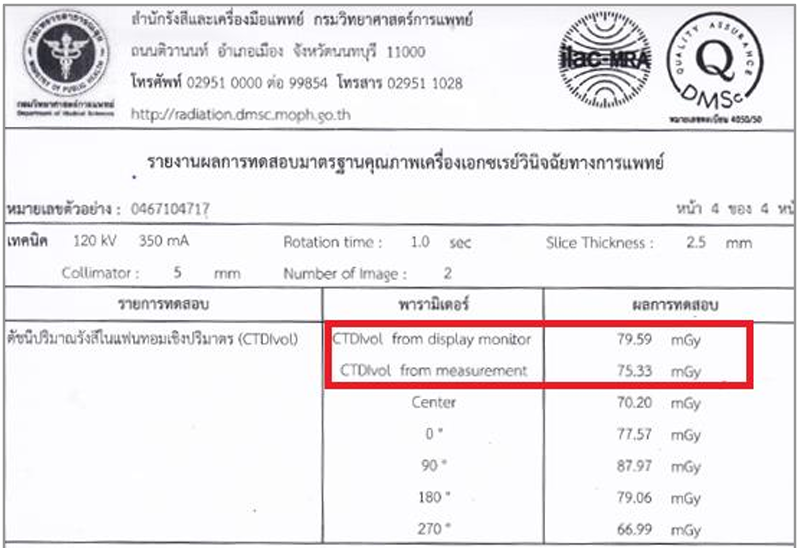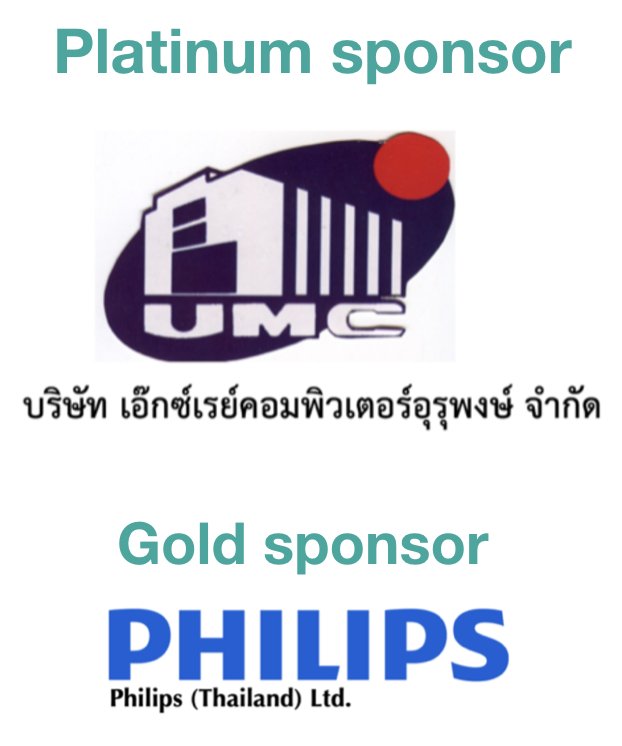การบริหารจัดการปริมาณรังสีที่เหมาะสมในผู้ป่วยเด็ก จากการตรวจเอกซเรย์คอมพิวเตอร์ด้วยค่าปริมาณรังสีอ้างอิง จากการถ่ายภาพรังสีวินิจฉัยการตรวจผู้ป่วยเด็ก
คำสำคัญ:
การตรวจเอกซเรย์คอมพิวเตอร์ในเด็ก, โปรโตคอลเฉพาะเจาะจงตามกลุ่มอายุและน้ำหนักตัว, ค่าปริมาณรังสีอ้างอิงจากการถ่ายภาพรังสีวินิจฉัย, การปรับใช้ปริมาณรังสีให้เหมาะสมบทคัดย่อ
เซลล์ของเด็กมีความไวต่อผลกระทบของรังสีมากกว่าผู้ใหญ่ ดังนั้นการเลือกใช้โปรโตคอลที่เฉพาะเจาะจงตามกลุ่มอายุและน้ำหนักตัวจึงมีความเหมาะสมมากกว่าการนำโปรโตคอลผู้ใหญ่มาใช้กับเด็ก ปริมาณรังสีอ้างอิงจากการถ่ายภาพรังสีวินิจฉัย (Diagnostic Reference Levels, DRLs) เป็นเครื่องมือที่มีประสิทธิภาพในการปรับใช้ปริมาณรังสีในการตรวจผู้ป่วยเด็กด้วยเครื่องเอกซเรย์คอมพิวเตอร์ให้มีความเหมาะสมในระดับที่ยอมรับได้และคุณภาพของภาพเพียงพอต่อการวินิจฉัยโรค ยึดตามหลักการป้องกันอันตรายจากรังสีที่ไม่ก่อให้เกิดประโยชน์ต่อผู้ป่วย ค่า DRLs ไม่ใช่ค่าปริมาณรังสีจำกัด แต่สามารถปรับเพิ่มหรือลดให้สอดคล้องกับระดับของคุณภาพของภาพที่ต้องการ ประโยชน์ที่สำคัญอีกประการของค่า DRLs คือการนำไปเปรียบเทียบกับค่าปริมาณรังสีอ้างอิงของประเทศ หรือระดับมาตรฐานสากลอื่นๆ แล้วนำมาใช้ในกระบวนการบริหารจัดการการใช้ค่าปริมาณรังสีให้เหมาะสม บทความนี้ ผู้เขียนมีวัตถุประสงค์ให้สามารถนำไปใช้เป็นแนวทางในการปรับค่าปริมาณรังสีที่เหมาะสมโดยเฉพาะในผู้ป่วยเด็ก
Downloads
References
Rehani MM. Radiological protection in computed tomography and cone beam computed tomography. Ann ICRP 2015;44: 229-35.
Kanal KM, Butler PF, Sengupta D, Bhargavan-Chatfield M, Coombs LP, Morin RL. U.S. diagnostic reference levels and achievable doses for 10 adult CT examinations. Radiology 2017;284: 120-33.
Parakh A, Kortesniemi M, Schindera ST. CT Radiation Dose Management: A Comprehensive optimization process for improving patient safety. Radiology 2016;280: 663-73.
Bibbo G, Brown S, Linke R. Diagnostic reference levels of paediatric computed tomography examinations performed at a dedicated Australian paediatric hospital. J Med Imaging Radiat Oncol 2016;60: 475-84.
Brenner D, Elliston C, Hall E, Berdon W. Estimated risks of radiation-induced fatal cancer from pediatric CT. AJR Am J Roentgenol 2001;176: 289-96.
Brenner DJ, Hall EJ. Computed tomography--an increasing source of radiation exposure. N Engl J Med 2007;357: 2277-84.
Mathews JD, Forsythe AV, Brady Z, Butler MW, Goergen SK, Byrnes GB, et al. Cancer risk in 680,000 people exposed to computed tomography scans in childhood or adolescence: data linkage study of 11 million Australians. BMJ. 2013; 21;346:f2360.
Nelson TR. Practical strategies to reduce pediatric CT radiation dose. J Am Coll Radiol. 2014;11(3): 292–9.
Cousins C, Miller D, Bernardi G, Rehani M, Schofield P, Vañó E, et al. International commission on radiological protection. 2011;120: 1-125.
Ministry of Public Health. National diagnostic reference levels in Thailand 2021. Available from: https://webapp1.dmsc.moph.go.th/
petitionxray/web3/download/DRLs66.pdf.
Strauss K, Boone J, Cody D, McCollough C, McNitt-Gray M, Toth T. Size specific dose estimates in pediatric and adult body CT examinations, AAPM Task Group 20142011.
European Guidelines on Diagnostic Reference Levels for Paediatric Imaging [Internet]. 2018. Available from: http://www.eurosafeimaging.org/
pidrl.Vañó
E, Miller D, Martin C, Rehani M, Kang K, Rosenstein M, et al. ICRP publication 135: diagnostic reference levels in medical imaging. Annals of the ICRP 2017;46: 1-144.
สํานักนโยบายและวิชาการสถิติ. เทคนิคการสุ่มตัวอย่างและการประมาณค่า [Available from: http://service.nso.go.th
Current Australian national diagnostic reference levels for multi detector computed tomography [Internet]. 2017. Available from: https://www.arpansa.gov.au/research-and-expertise/surveys/national-diagnostic-reference-level-service/current-australian-drls/mdct.
Kanal KM, Butler PF, Chatfield MB, Wells J, Samei E, Simanowith M, et al. US diagnostic reference levels and achievable doses for 10 pediatric CT examinations. Radiology 2022;302: 164-74.
Edyvean S, Lewis M, Britten A. Radiation dose metrics and the effect of CT scan protocol parameters. Radiation dose from multidetector CT: Springer; 2012:101-18.
Granata C, Sorantin E, Seuri R, Owens CM. European Society of Paediatric Radiology Computed Tomography and Dose Task Force: European guidelines on diagnostic reference levels for paediatric imaging. Pediatr Radiol. 2019;49(5):702–5.
Matsunaga Y, Chida K, Kondo Y, Kobayashi K, Kobayashi M, Minami K, et al. Diagnostic reference levels and achievable doses for common computed tomography examinations: Results from the Japanese nationwide dose survey. Br J Radiol 2019;92: 20180290.
Kanda R, Akahane M, Koba Y, Chang W, Akahane K, Okuda Y, et al. Developing diagnostic reference levels in Japan. Jpn J Radiol. 2021;39(3): 307–14.
Brady Z, Ramanauskas F, Cain TM, Johnston PN. Assessment of paediatric CT dose indicators for the purpose of optimisation. Br J Radiol 2012;85: 1488-98.
Hwang J-Y, Choi YH, Yoon HM, Ryu YJ, Shin HJ, Kim HG, et al. Establishment of local diagnostic reference levels of pediatric abdominopelvic and chest CT examinations based on body weight and size in Korea. Korean J Radiol. 2021;22(7): 1172–82.
Admontree S, Junsorn S, Tathip R, Todsatidpaisan S, Buachan P, Asavaphatiboon S. Evaluation of size-specific dose estimates (SSDE) in pediatric body imaging using 320-detector CT. Naresuan Univ J Sci Technol. 2019;27(2):28-35.
Kritsaneepaiboon S, Trinavarat P, Visrutaratna PJAr. Survey of pediatric MDCT radiation dose from university hospitals in Thailand: a preliminary for national dose survey. Acta radiologica 2012;53: 820-6.
Bosmans H, Damilakis J, Ducou le Pointe H, Foley SJ. Radiation protection no. 185 European guidelines on diagnostic reference levels for paediatric imaging. 2018.
McCollough C, Bakalyar DM, Bostani M, Brady S, Boedeker K, Boone JM, et al. Use of water equivalent diameter for calculating patient size and size-specific dose estimates (SSDE) in CT: The Report of AAPM Task Group 220. AAPM Rep. 2014:6-23.
Pimsorn P. Factors affecting size-specific dose estimates in addition to scanning parameters for chest-abdomen-pelvis computed tomography using automatic tube current modulation at Chiangrai prachanukroh hospital. Thai J Rad Tech 2022 ;47(1):43-54.
Wattanasriroj Y, Punthaisiri P, Kingkaew S, Wisetrinthong M, Oonsiri S. The effect of tube voltage and current on the CT number and relative electron density in computed tomography simulator. Thai J Rad Tech 2023;48(1):18-28.
Poosiri S, Krisanachinda A, Khamwan K. Evaluation of patient radiation dose and risk of cancer from CT examinations. Radiol Phys Technol. 2024 Mar;17(1):176-85.
Ruenjit S, Siricharoen P, Khamwan K. Automated size-specific dose estimates framework in thoracic CT using convolutional neural network based on U-Net model. J Appl Clin Med Phys. 2024 Mar;25(3):e14283.

Downloads
เผยแพร่แล้ว
How to Cite
ฉบับ
บท
License
Copyright (c) 2024 สมาคมรังสีเทคนิคแห่งประเทศไทย

This work is licensed under a Creative Commons Attribution-NonCommercial-NoDerivatives 4.0 International License.
บทความที่ได้รับการตีพิมพ์เป็นลิขสิทธิ์ของสมาคมรังสีเทคนิคแห่งประเทศไทย (The Thai Society of Radiological Technologists)
ข้อความที่ปรากฏในบทความแต่ละเรื่องในวารสารวิชาการเล่มนี้เป็นความคิดเห็นส่วนตัวของผู้เขียนแต่ละท่านไม่เกี่ยวข้องกับสมาคมรังสีเทคนิคแห่งประเทศไทยและบุคคลากรท่านอื่น ๆในสมาคม ฯ แต่อย่างใด ความรับผิดชอบองค์ประกอบทั้งหมดของบทความแต่ละเรื่องเป็นของผู้เขียนแต่ละท่าน หากมีความผิดพลาดใดๆ ผู้เขียนแต่ละท่านจะรับผิดชอบบทความของตนเองแต่ผู้เดียว



